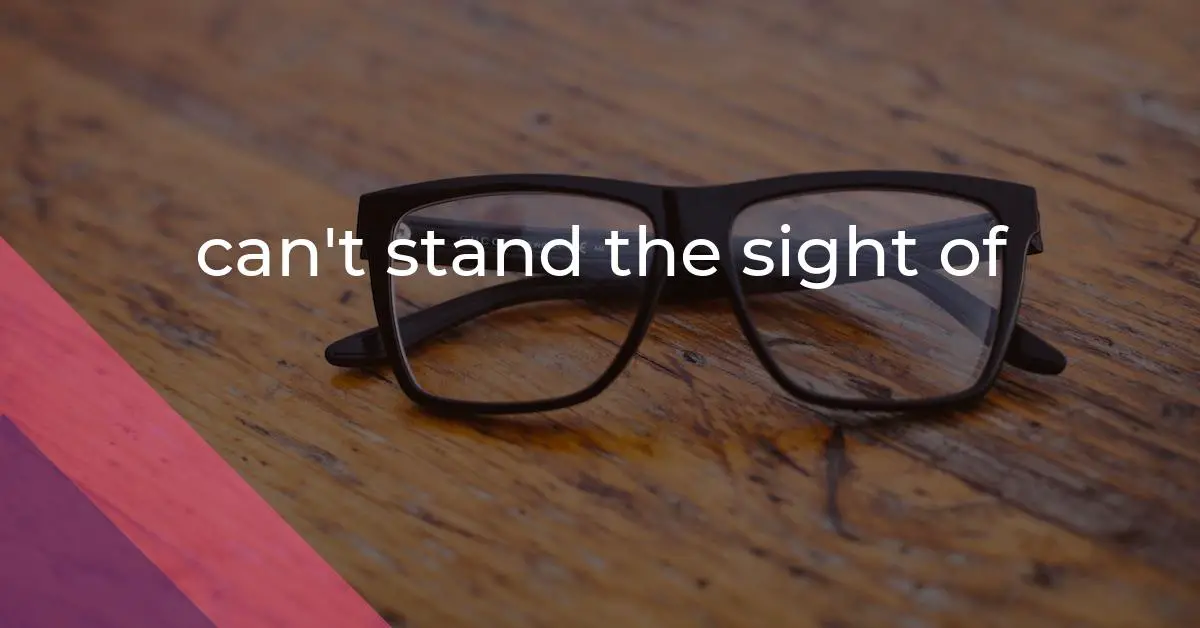can’t stand the sight of: Idiom Meaning and Origin
What does ‘can't stand the sight of’ mean?
The idiom "can't stand the sight of" means to have a strong dislike or aversion towards someone or something, often to the point of being unable to tolerate their presence or even looking at them.

Idiom Explorer
The idiom "lay eyes on" means to see or look at something. It implies that the person looking at something has a strong desire or interest in it.
The idiom "in someone's face" means to confront or challenge someone in a direct and aggressive manner, often done to assert dominance or to express anger or frustration.
The idiom "I'd like to see someone try" means expressing a strong desire to witness someone attempt something perceived as challenging or impossible. It implies doubt or skepticism about the person's ability to succeed.
The idiom "heaven forbid" is used to express a strong desire for something not to happen, often followed by a negative outcome. It is often used to emphasize the speaker's hope or wish to avoid a particular situation.
The idiom "have no time for" means to have a negative opinion or lack of interest in someone or something.
It suggests a lack of patience or willingness to engage, often due to disapproval or indifference.
The idiom "have had it up to here" means being extremely frustrated or fed up with something. It signifies reaching a limit or threshold of tolerance.
An idiom meaning someone has an extremely unattractive or unpleasant face, often used to give a brutally honest description of someone's appearance.
The idiom "hate someone's guts" means to have a strong and intense dislike or hatred towards someone, often based on negative feelings towards their character or actions.
Insufferable Visuals
The idiom "can't stand the sight of" is a common expression that conveys a strong aversion or dislike towards someone or something. This expression originated in the late 18th century and is widely used in English-speaking countries, particularly the United States. It is often used informally to emphasize a deep emotional repulsion.
One example of how this idiom is used is in sentences like "I can't stand the sight of that person" or "I can't stand the sight of onions." In both cases, the speaker is expressing a strong dislike or distaste for the subject mentioned.
It's interesting to analyze the literal meaning of this idiom. Taken literally, it suggests an inability to physically tolerate being in the presence of whatever is being referred to. However, the idiom is understood figuratively, and its true meaning lies in the intense emotional response it conveys.
The figurative meaning of "can't stand the sight of" suggests a deep emotional reaction where the mere presence of someone or something is perceived as unbearable. This feeling of aversion can arise from a variety of factors, such as personal experiences, conflicting opinions, or individual preferences.
This idiom's strength lies in its ability to evoke an intense negative emotion. By emphasizing the inability to "stand" the very "sight" of someone or something, it implies an overwhelming feeling of antipathy or disgust.
In considering the related idioms "can't stand" and "hard on the eyes," it becomes evident that they share a similar underlying sentiment. "Can't stand" is a phrase used to express a strong dislike or annoyance towards someone or something, while "hard on the eyes" refers to something that is visually unappealing or difficult to look at.
Both of these idioms highlight a negative emotional response, whether it be a deep aversion or physical discomfort. The figurative language used in these idioms serves to emphasize the intensity of the emotions being conveyed.
When examining the phrase "hard on the eyes," it becomes clear that it aligns closely with the concept of "can't stand the sight of." Both expressions revolve around the idea of visual perception and the negative emotions that can arise from it.
While the idiom "can't stand the sight of" directly addresses an aversion or dislike towards someone or something, "hard on the eyes" focuses more on the visual aspect itself. The phrase implies that what is being seen is unattractive or uncomfortable.
Therefore, when used in conjunction with "can't stand the sight of," the idiom "hard on the eyes" further emphasizes the strong negative reaction being conveyed. It adds another layer to the expression, underscoring the visual unappealing nature of the subject.
The idiom "can't stand the sight of" is a widely used expression that represents a strong aversion or dislike towards someone or something. Its figurative meaning relies on the emotional response it conveys rather than its literal interpretation. When combined with related idioms such as "can't stand" and "hard on the eyes," the intensified negative emotions associated with the aversion become more apparent. These idioms serve to emphasize the power of visual perception and the deep emotional impact it can have.
Example usage
Examples of how the idiom *can't stand the sight of* can be used in a sentence:
- I can't stand the sight of spiders. They really freak me out.
- She can't stand the sight of her ex-boyfriend. It brings back too many painful memories.
- He can't stand the sight of blood. It makes him feel nauseous.
More "Verbs" idioms



